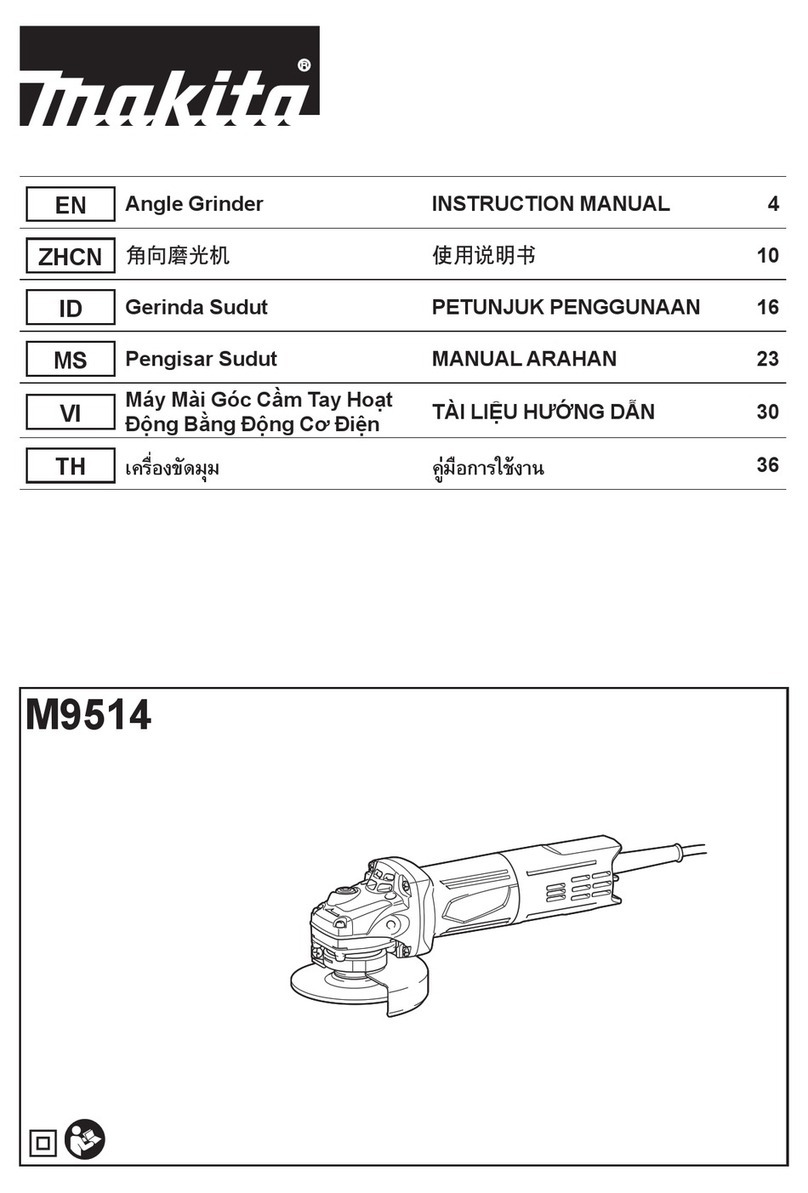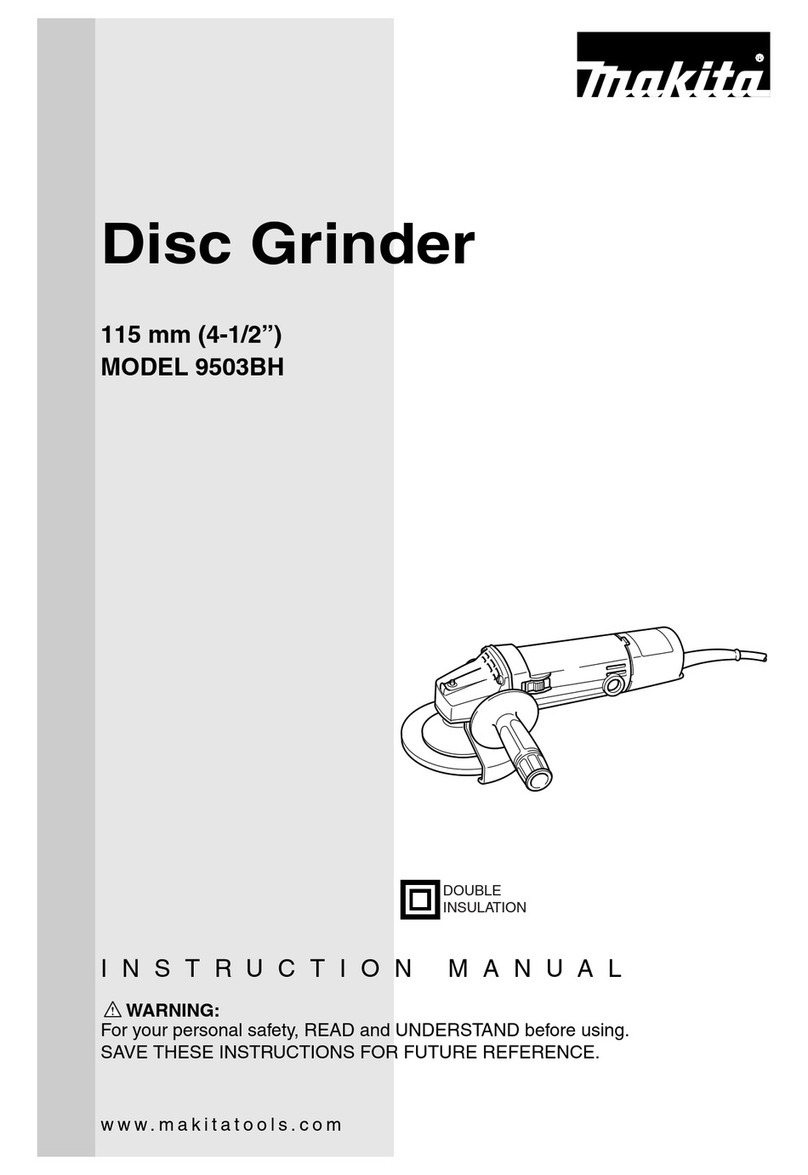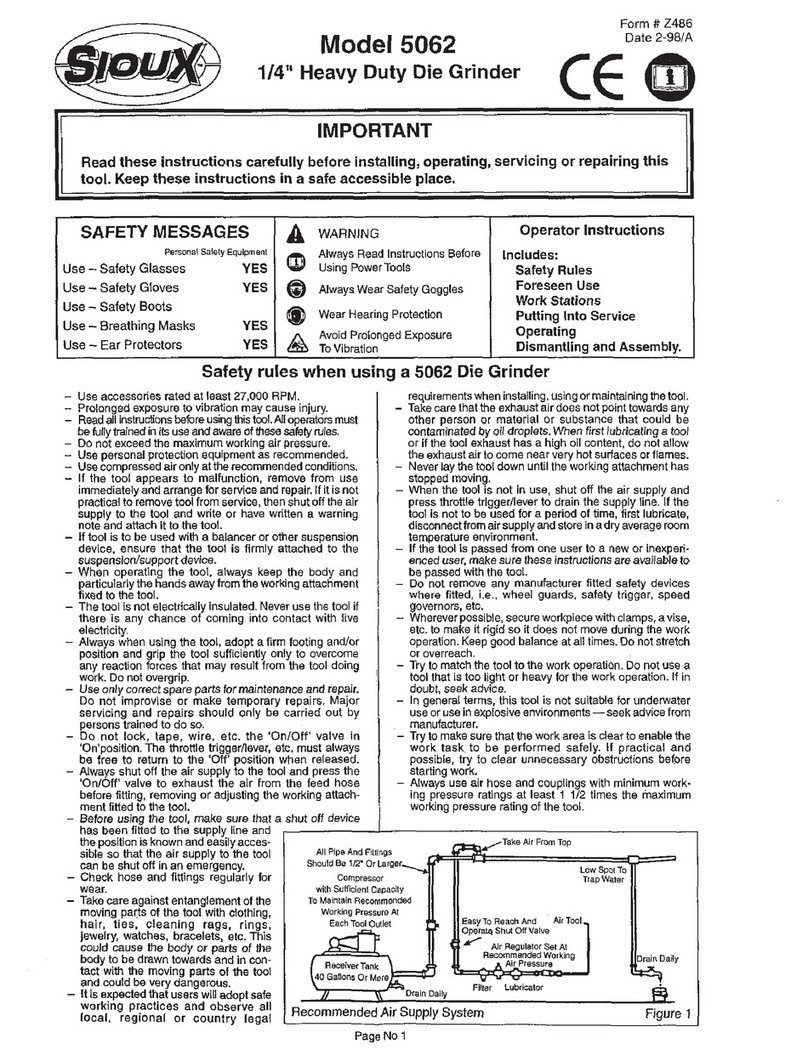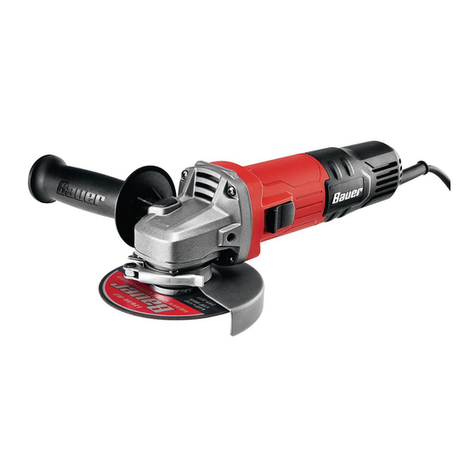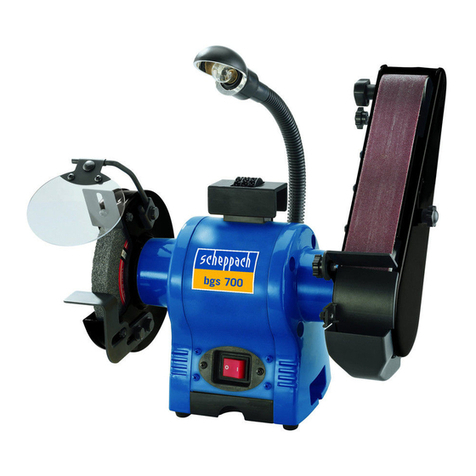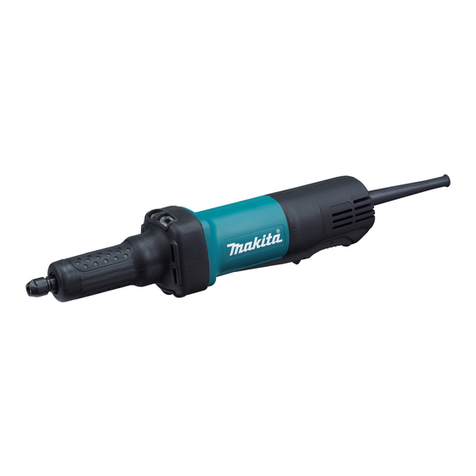RJH FINISHING SYSTEMS BR Series User manual

© RJH FINISHING SYSTEMS 2012
ISSUE E
BEAR
INSTRUCTION MANUAL

2
DECLARATION OF CONFORMITY
We, the company:
RJH Finishing Systems Ltd.
Artillery Street,
Heckmondwike,
West Yorkshire,
WF16 0NR.
Tel: (01924) 402490
Fax: (01924) 404635
Hereby declare that:
Tool Grinders (BR Series)
Serial No:
Year of Manufacture: 2012
Are considered to be in conformity with the following:
Harmonised Standards:
BS EN ISO 12100:2010, BS EN ISO 13850:2008, BS EN 614-1:2006, BS EN 60204-1:2006,
BS EN ISO 13857:2008
British Standards: 4163:2007
And meets the Essential Health and Safety Requirements of Machinery Directive
2006/42/EC and subsequent amendments. Electrical control and its Components are in
accordance with the Low Voltage (2006/95/EC) and EMC (2004/108/EC) Directives.
Signed by:
J.R.Gathercole C.Eng
Engineering Director
For and on behalf of RJH Finishing Systems Ltd.
CERTIFICATE OF CONFORMITY

3
Due to a policy of continuous improvement,
your machine may differ slightly to the
exhibits shown in this manual
1. Safe Handling & Installation
2. Safety
3. Machine Operation
4. Maintenance
5. Risk Assessment
6. Troubleshooting
Appendix
1. Recommended Spare Parts
2. Machine Footprint
3. Cutting Oil Data Sheet
4. Contact Details
CONTENTS

4
1.1 GENERAL DESCRIPTION
These robust tool grinders come with an integral force fed re-circulatory coolant
system, filter and oil reservoir. They are supplied with grinding wheels fitted as
standard and are therefore ready to use once installation has been completed.
NOTE: A can of grinding wheel oil is supplied with the compliments of RJH Finishing
Systems Ltd.
1.2 SAFE OFF-LOADING & POSITIONING
The Bear tool grinder is a stable, freestanding unit with a sizable footprint and
consequently a good resistance to toppling. The machine is supplied bolted to a pallet so
that it can be safely lifted, transported and positioned as described below.
NOTE!!! THOUGH IMAGES SHOWN ARE OF A DIFFERENT MACHINE THE METHOD
FOR OFFLOADING IS THE SAME.
SECTION ONE
SAFE HANDLING & INSTALLATION
1. Remove the two base covers
to expose transit bolts.
2. Release & Remove the transit
bolts (see insert).
3. Position Fork Lift extensions
in-line with pallet top.
4. Slide the machine onto the fork lift
extensions.

5
PLEASE NOTE!!! For protection during transit certain components may have been
packed separately around the base of the machine. A wall chart highlighting operational
methods is supplied with the machine. This wall chart should be displayed near to the
machine when in its final position.
GREAT CARE MUST ALWAYS BE TAKEN WHEN MOVING ALL MACHINES, TO PREVENT
INJURY AND DAMAGE. ONLY SUITABLY TRAINED PERSONNEL SHOULD
LIFT/MANOEUVRE HEAVY MACHINERY TO AVOID INJURY/DAMAGE TO BOTH
INDIVIDUALS AND EQUIPMENT. ONCE THE MACHINE HAS BEEN UNPACKED, IT
SHOULD BE FULLY INSTALLED AS DESCRIBED.
1.3 MACHINE WEIGHT
MACHINE MODEL
PACKED WEIGHT (Kg)
BEAR1
105
BEAR2
115
1.4 INSTALLATION
Refer to Appendix 2 for individual machine footprints.
It is recommended that a minimum area of 1m is allowed at the front of the machine for
general operation (including opening cabinet door) and a further 0.5m to the rear of the
machine to allow access for maintenance work.
The Bear2 and Bear2S models have a left hand cone wheel attachment. An additional
1m should be allowed to gain access to this attachment.
SECTION ONE
SAFE HANDLING & INSTALLATION
5. With the machine sat stable
on the Fork Lift extensions –
lower to the ground.
6. Slide the machine off the Fork
Lift extensions onto the ground.

6
Position the machine so that it does not cause obstruction in
use. The machine must be securely bolted through the holes
provided using proprietary bolts (Para-bolts/Raw-bolts)
with ∅10mm and 60mm length. Access is gained by
removing the two base covers as shown.
Before use the machine needs to be filled with oil. Refer to
section 4.3.
1.5 ELECTRICAL DETAILS
Ensure that the mains electrical supply complies with the supply voltage indicated on
the serial name plate and connect the machine to the electrical supply. A qualified
electrician MUST always carry this out and earth connections must be provided.
THREE PHASE UNITS –should be connected to a fused isolator, 3 phase electrical
supply of 400v, 50Hz, 10amp capacity. Check that the terminal panel connections
correspond to the mains supply. Once the machine has been connected, press START
button and check grinding wheel is rotating clockwise when viewed from above. If not,
isolate the machine and switch two phases around.
SINGLE PHASE UNITS –machines are supplied with a suitable plug, but can be hard
wired to a fused 13amp electrical supply if required.
MODEL
Kw
ELECTRICS
FLC
amps
FUSE RATE
amps
BEAR1 & BEAR2
0.18
400/3/50
0.5
5
BEAR1S & BEAR2S
0.25
230/1/50
2.3
5
SECTION ONE
SAFE HANDLING & INSTALLATION

7
2.1 SAFETY FEATURES
These tool grinders are supplied in accordance with the European Machinery Directive
2006/42/EC and subsequent amendments.
2.2 STANDARD SAFETY FEATURES
No volt overload push button starter, which will stop the machine if the motor
becomes overloaded or if a power failure is incurred. The machine will NOT restart
until the STOP button is released and START button pressed.
Automatic safety cut out when cabinet door is opened.
2.3 OPTIONAL SAFETY FEATURES
Foot stop switch and lockable triple pole isolator can be supplied if required.
2.4 VIBRATION
Hand Arm Vibration is a consideration with all off-hand operations. Whilst the idling
vibration generated is generally less than the 2.5m/s²(A8 target limit), though levels in
excess of this may be experienced by the operator.
Depending on the nature of the operation and load applied by the operator,
accelerations in the 3-5m/s²range are possible and in such cases, exposure times may
need to be reduced to meet the A8 (2.5m/s²) target, typically 5.5 hours for a level of
3m/s²and 2 hours for a level of 5m/s²maximum. However, due to the nature of these
machines exposure times tend to be limited and so it is likely that the A8 target can be
achieved in most cases.
In production environments, these values can only be determined by assessment in
operation by using hand arm monitoring equipment. The regular checking of wheels
etc... is highly recommended to prevent abnormal vibrations being experienced.
2.5 NOISE EMISSIONS
Under normal operating conditions the noise level is below 80dbA and ear protection is
not mandatory. However, depending on the consumables used and work piece material,
the noise level can in some cases rise above the 80dbA threshold, in which case ear
defenders are MANDATORY.
2.6 MANDATORY PPE
SECTION TWO
SAFETY
SAFETY GLASSES ARE
MANDATORY
EAR DEFENDERS ARE
MANDATORY

8
2.7 SAFE WORKING PRACTICES
Bear machines have been designed and manufactured to provide many years reliable
service as a tool grinder. Use for any other purpose may lead to personal injury
and/or damage to the machine.
Persons operating these machines should be thoroughly familiar with the properties
and hazards attached to both the machine and any work piece material.
Rules regarding the wearing of protective clothing should be enforced.
Don’t wear a tie, jewellery or loose clothing whilst operating the machine and ensure
long hair is tied back preventing entanglement.
It is important that wheels are kept in good condition –please refer to section 4.5
grinding wheel maintenance.
Any oil spillage should be cleaned up immediately to avoid accidents.
SECTION TWO
SAFETY
DO’S
DONT’S
Always wear suitable eye protection
Force sharp or knife like objects into the
wheel, as this will lead to wheel
disintegration.
Clean the machine regularly especially
when polishing different types of materials
Enter the electrical control panel unless
qualified and the electrical supply is
isolated
Monitor the vibration levels of the machine
and operators

9
3.1 SHARPENING A CHISEL/PLANE BLADE
Ensure that every operator has been instructed in the use of all the machine controls.
Insert the swivel arm into the inspection position Fig 1.
Slacken the black knurled knob in the swivel arm and insert the blade to be
sharpened, allowing enough protrusion of the blade to ensure that the tool carrier is
clear of the grinding wheel. Re-tighten the knurled knob.
Move the swivel arm back to the grinding position as shown in Fig 2. Position the
blade ensuring that the edge is flat on the grinding wheel, which is necessary to
ensure an even grind.
If the blade is not flat, it needs to be adjusted. Do this by loosening the locking screw
in the centre of the swivel arm using an allen key and reposition the blade edge.
Set the required angle by moving the swivel arm on the support column until the
required angle is achieved.
Retighten the locking screw.
Press the START button to initiate the machine. To stop the machine, press the STOP
button or FOOT STOP depending on which machine model.
Set the cutting oil flow rate using the control valve. Ensure that the grinding wheel is
adequately lubricated throughout the grinding process.
The blade can be inspected at any time by lifting the swivel arm up into the
inspection position.
3.2 GOUGE SHARPENING
In order to sharpen gouges which have both inner and outer edges, it is necessary to
use the radius attachment. NOTE!!! The radius attachment is supplied with Bear2
models only.
Insert blade to be sharpened as detailed in section 3.1.
In addition to section 3.1, use the top handle on the tool holder to rotate the gouge
back and forth throughout the grinding process. This will grind a radius round the
full edge of the gouge.
SECTION THREE
MACHINE OPERATION
FIG 1
FIG 2

10
3.3 CONE WHEEL –BEAR2 MODELS ONLY
The cone wheel is used to remove any burrs formed on the inner face of a gouge after
sharpening.
Adjust the height of the work rest to the required position.
Start the machine and set the oil flow rate.
Gently put the gouge inner onto the cone to remove any burrs. Be careful not to apply
too much pressure onto the wheel.
3.4 DRESSING THE WHEEL
Over time the grinding wheel will become worn or glazed. To return it to effective
grinding it is necessary to ‘dress’ the wheel.
To use the wheel dresser, remove the swivel arm or radius attachment from the
support column.
Fit the wheel dresser arm onto the support column and secure in place by tightening
the socket screw into the pre-drilled dimple on the support column. Ensure that the
diamond point on the wheel dresser is clear of the wheel.
Unlock the locking nut on the wheel dresser adjustment screw and move the dresser
close to the wheel.
Turn oil feed off and move arm away from the wheel. Now start the machine.
Move the arm across the face of the wheel, lowering the dresser so that it takes a
small cut into the wheel. Repeat this action once more and then bring the arm off the
wheel. Lower the dresser again and re-tighten locking nut.
Move the arm back and forth across the face of the wheel in a smooth action until no
more cutting takes place. If necessary lower the dresser further and repeat this step
until the wheel is fully dressed.
Stop the machine, remove the wheel dresser and replace the swivel arm. Remember
to turn the oil feed on.
SECTION THREE
MACHINE OPERATION

11
4.1 GENERAL
All machines in this family are relatively simple and need little attention by way of
maintenance.
The machine is fitted with sealed for life bearings and will require no further
lubrication.
It is recommended that any dust/debris is periodically cleaned off.
Check the machine after each use for damage or broken parts and repair/replace
parts immediately.
4.2 ELECTRICAL
Electrical control circuits must be checked by authorised personnel only.
Access to the contactor assembly is via the inspection hatch on the right hand side
when viewed from the front.
4.3 FILLING THE OIL RESERVOIR
Ensure that the machine is turned off and open the cabinet door.
Fill the tank with approximately 2.5litres of the oil provided. Once filled, the oil
should cover the brass filter. Check that all the drain pipes are located within the
large compartment of the tank, which has a separate filter.
Close the cabinet door and start the machine.
Adjust the flow of oil onto the wheel using the tap in the rear left hand corner. There
should be sufficient oil to lubricate the grinding wheel without flooding it. Any excess
oil will drain back into the tank.
Over time the grinding wheel will soak up the oil, particularly when it is a new wheel.
It is important that the oil level in the tank is maintained and should be checked
regularly.
4.4 CLEANING THE FILTER
Ensure that the machine is turned off and open the cabinet door.
Unbolt the filter tray. Remove the filter from the tray and wash it in paraffin to
remove excessive build-up of waste grinding materials.
Replace the clean filter and close the cabinet door. It is now safe to start the machine.
4.5 GRINDING WHEEL MAINTENANCE
Every wheel must carry an indication of the maker, binder, wheel dimensions and
maximum permissible speed.
All Bear machines are designed to accept ∅406 x 32mm wheels.
New wheels should be subjected to a ‘ringing’ test before being fitted. A ringing test
entails a light tap on the wheel which should produce a clear ringing noise.
SECTION FOUR
MAINTENANCE

12
Chipped or damaged wheels should be replaced immediately.
If a grinding wheel is to cut properly it must run true and not be ‘loaded’ or ‘glazed’.
Loading is when the porous structure of the wheel becomes clogged with work piece
material. Loading can occur when:
1. Soft materials are being ground.
2. The wheel is too hard for a particular job.
3. The wheel has been used repeatedly without dressing.
When ‘loading’ is evident the grinding wheel should be dressed by means of a wheel
dresser such as a diamond dresser, leaving the surface of the wheel clean and edges
neatly rounded.
Keep spare wheels in a dry place at an even temperature and always in accordance
with manufacturer’s instructions.
4.6 VIBRATION & CHATTER
Vibration causes the wheel to wear unevenly and chatter marks will appear on the work
surface. These may be caused by:
1. The machine not being correctly mounted.
2. Loose bearings.
3. Wheel being out of balance.
4. Build up of dust and grease on the grinding wheel.
4.7 GRINDING WHEEL SELECTION
When selecting the grit and grade of a grinding wheel for a particular application the
following guidelines should be taken into account.
1. MATERIAL TO BE GROUND –In general the harder the work piece material
the softer the grade of wheel required. Aluminium Oxide should be used for
grinding metals of high tensile strength such as steel. Carbon Silicate should be
used for metals with low tensile strength such as brass or cast iron.
2. STOCK MATERIAL TO BE REMOVED –For rapid material removal when a
perfect finish is not required, a course grade open structure wheel is ideal.
3. FINISH –To a large extent the finish depends upon the grain size used in the
wheel.
4. WHEEL CONTACT –Greater the area of contact between wheel and work piece,
the softer the wheel required e.g. surface grinding with the periphery of a wheel
where area approximates a line, requires a harder and finer wheel than when
surface grinding with a cup wheel where the area of contact is comparatively
large.
5. WHEEL SPEED –Hard wheels can be made softer by running them at a slow
speed. It is advisable to run a grinding wheel at the speed recommended by the
manufacturer and never exceed the stated maximum operating speed.
SECTION FOUR
MAINTENANCE

13
4.8 WHEEL CHANGE
Grinding wheels MUST be changed by suitably trained personnel and in accordance
with the Abrasive Wheels Regulations.
Isolate/disconnect the power supply.
Remove the nut on the spindle and take off the wheel with the clamp plates.
Clean the area prior to fitting the new wheel.
Replace the wheel.
Ensure that blotters are correctly fitted between the clamp plates and wheel. Only
use the original clamp plates supplied with the machine.
Lock the wheel in place using the supplied nut and clamp plates, ensure the wheel
rotates correctly.
SECTION FOUR
MAINTENANCE

14
5.1 RISK ASSESSMENT
Bear machines have been developed from machines that RJH Finishing Systems Ltd
have supplied into the market place for many years and have an excellent safety
pedigree. However, like all machines of this type they can be dangerous if used
carelessly or incorrectly.
It is therefore essential that all HAZARDS are identified and SAFE WORKING
PRACTICES are adhered to. What follows is an assessment of the RISKS.
5.2 HAZARDS
FIRE & EXPLOSION not considered to be of any great risk since the grinding process is
well lubricated.
LOW RISK
LIMB ABRASION probably the most common hazard since the process of manual
grinding involves contact with the abrasive wheel, which can lead to skin abrasion.
Good quality gloves (Chrome or Leather) are recommended.
LOW RISK
ENTANGLEMENT potentially the most serious risk since the top of the wheel is
exposed, but provided the safe working practices are followed the risk is considered to
be low.
LOW RISK
BURNING as with all grinding processes considerable heat can be generated in the work
piece and burning of the skin can result if handled carelessly. Good quality gloves
(Chrome or Leather) are strongly recommended along with a quenching aid such as
water etc…
LOW RISK
ELECTROCUTION all electrically powered appliances have the potential to kill. Even
though the machine has simple electrical controls with isolation, overloads, emergency
stop and no volt release there remains a danger. Only qualified personnel MUST access
the control panel.
LOW RISK
EYE DAMAGE with any grinding process there is the possibility of dust/debris entering
the eye(s). The wearing of safety glasses is MANDATORY.
LOW RISK
SECTION FIVE
RISK ASSESSMENT

15
EJECTION OF PARTS/COMPONENTS is present with all grinding processes. Avoid
applying excessive pressure or pressing sharp objects into the wheel as this will
increase the risk of ejection and can result in wheel damage or even breakage.
LOW RISK
VIBRATION caused by the operation will be transmitted to the operator’s arm(s) and in
extreme cases can lead to Hand Arm Vibration Syndrome. The idling vibration is
generally less than 0.5m/s². However, the problem is more operation related than
simply a function of the machine, consumables and process techniques require
evaluation and close monitoring.
TO BE ASSESSED
NOISE depends on the consumables used during operation. Machines such as this will
usually be below 80dbA though it is still highly recommended that ear defenders are
worn.
LOW-MEDIUM RISK
This type of manual equipment has been available for decades and the various
processes with their associated operating hazards are well known, largely chronicled
and manageable. It is our belief that with good operator training and adherence to the
safe working practices this family of machines can be considered to have an overall
LOW RISK for the purposes of the Provision and Use of Work Equipment Regulations
(PUWER).
SECTION FIVE
RISK ASSESSMENT

16
SYMPTOM
CHECK
ACTION
Machine will not start
Mains On
Emergency Stop
Control Overloads
Control Fuses
Switch on Isolator
Release ‘E’ Stop
Requires Electrician
Requires Electrician
No oil feed
Pipes
Control valve
Tank oil level
Clear blockages
Open if closed
Top up if necessary
Poor Grinding
Performance
Wheel selection
Wheel condition
Replace with more
appropriate wheel for the
job. Seek advice if needed.
Replace if necessary
SECTION SIX
TROUBLESHOOTING

17
PART NO
DESCRIPTION
QTY
7242-001
START BUTTON
1
7242-002
STOP BUTTON
1
8625-001
OIL (5 LITRE)
1
BRFILTER
FILTER BLOCK
1
H BRA80
GRINDING WHEEL
1
O BRRAO
RADIUS ARM
1
BER-1-0071
CHISEL ARM ASSEMBLY
1
H BRA80/17
CONE WHEEL
1
7373-164
NON RETURN VALVE
1
N100024
PUMP
1
BER-1-0022
LID ASSEMBLY
1
L 10036
PRESSURE RELEASE VALVE
1
K BEARSEALS
OIL SEAL
1
N LINKBELT
DRIVE BELT
1
L 10046
STRAINER
1
APPENDIX ONE
RECOMMENDED SPARE PARTS

18
BEAR1 TOOL GRINDER
APPENDIX TWO
MACHINE FOOTPRINT

19
Front Side
BEAR2 TOOL GRINDER
APPENDIX TWO
MACHINE FOOTPRINT

20
Health & Safety
Data Sheet
NEAT CUTTING OILS
PENNINE LUBRICANTS
UNIT 35, NUTWOOD TRADING ESTATE
LIMESTONE COTTAGE LANE
SHEFFIELD
S6 1NL
TEL: 0114 2852987
FAX: 0114 2852988
PRODUCT NAME: METACUT 22, 32, T, G, H, AL, CF, BC, HONING FLUID, FORM
GRINDING OIL, COMBICUT FG
PRODUCT CODE: AF0, AF1, AF2, AF3, AF4, AF5, AF7, AF9, AES, AXX1
APPLICATION: Neat metalworking fluids.
2. COMPOSITION / INFORMATION ON INGREDIENTS
General: These products are based on highly refined mineral oil with additives, some containing chlorinated
paraffins.
3. HAZARD IDENTIFICATION
General: These products are not classified as hazardous.
4. FIRST AID MEASURES
Eyes: Immediately wash eye thoroughly with plenty of clean water.
Skin: Following contact with the product, wash thoroughly with soap and water. Remove heavily contaminated
clothing. wash contaminated clothing before re-use. If irritation persists, obtain medical advice.
Ingestion: DO NOT INDUCE VOMITING. Wash out mouth with water and obtain medical attention. Treat
symptomatically. If aspiration is suspected, obtain immediate medical attention.
Pressure Injection: Always obtain immediate medical attention.
5. FIRE FIGHTING MEASURES
Flammability: May support combustion in a serious fire.
Extinguishing Media: Foam, dry powder, CO2, sand or earth.
Products of Combustion:See Section 10
6. ACCIDENTAL RELEASE MEASURES
Always prevent entry into drains or watercourses.
Spillages can be slippery.
Small Spills: Soak in absorbent granules or sand.
Large Spills: Bund using absorbent granules, sand or earth and reclaim bulk liquid.
Disposal of Spillage: Via authorised waste disposal contractor. Disposal must be in accordance with the
Environmental Protection Act 1990.
7. HANDLING AND STORAGE
Handling: To avoid the possibility of skin disorders, avoid repeated or prolonged contact with the product.
Storage: Store in dry conditions between 0 and 40o C.
8. EXPOSURE CONTROL / PERSONAL PROTECTION
Exposure Limits: As for mineral oil mist: 5mg/m3 (8 Hr TWA)
APPENDIX THREE
CUTTING OIL DATA SHEET
This manual suits for next models
1
Table of contents
Popular Grinder manuals by other brands
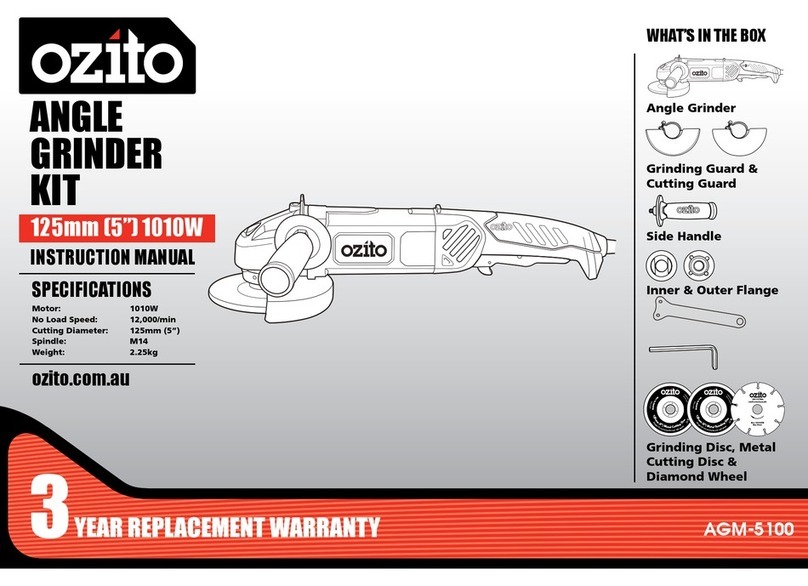
Ozito
Ozito ANGLE GRINDER KIT instruction manual

Clarke
Clarke CBG8W operating & maintenance manual
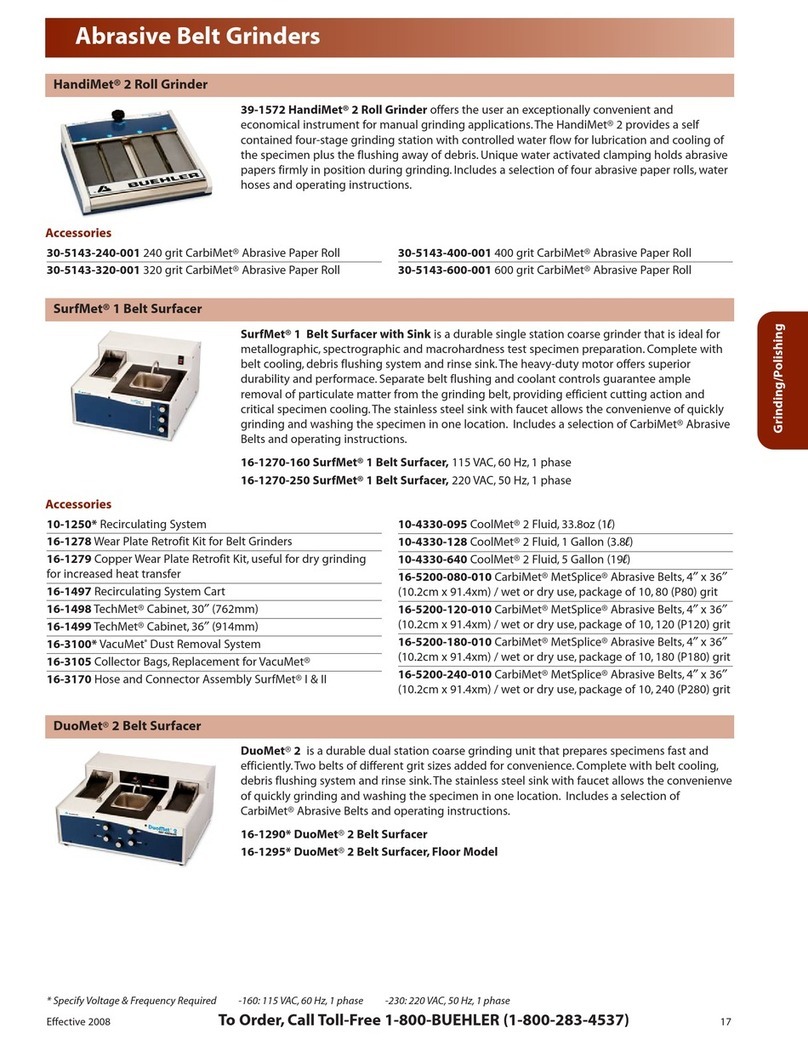
Buehler
Buehler 39-1572 Catalog
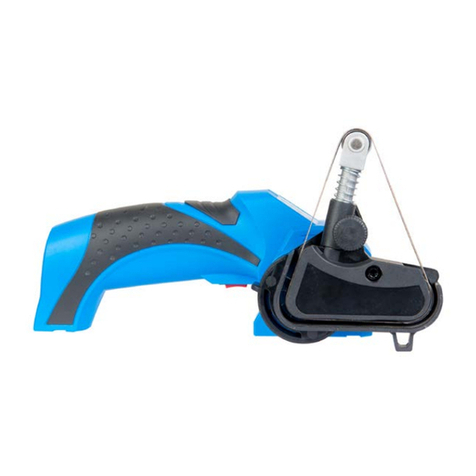
Westfalia
Westfalia MS 7.2 Li Original instruction manual
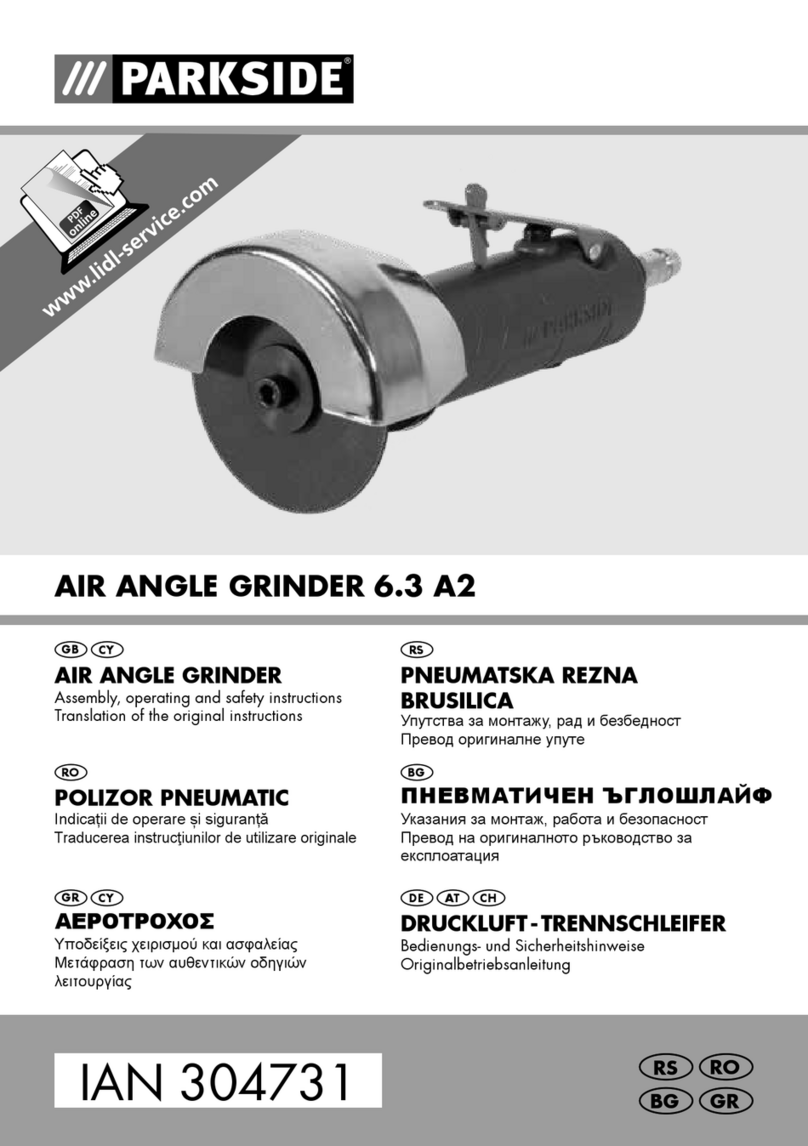
Parkside
Parkside 6.3 A2 Assembly, operating and safety instructions, Translation of the original instructions

Parkside
Parkside PWS 1200 - 2 Operation and safety notes

Flott
Flott BSM 75 A operating instructions

Hitachi Koki
Hitachi Koki G 18MR Handling instructions

Mighty Seven
Mighty Seven DG-585 user manual
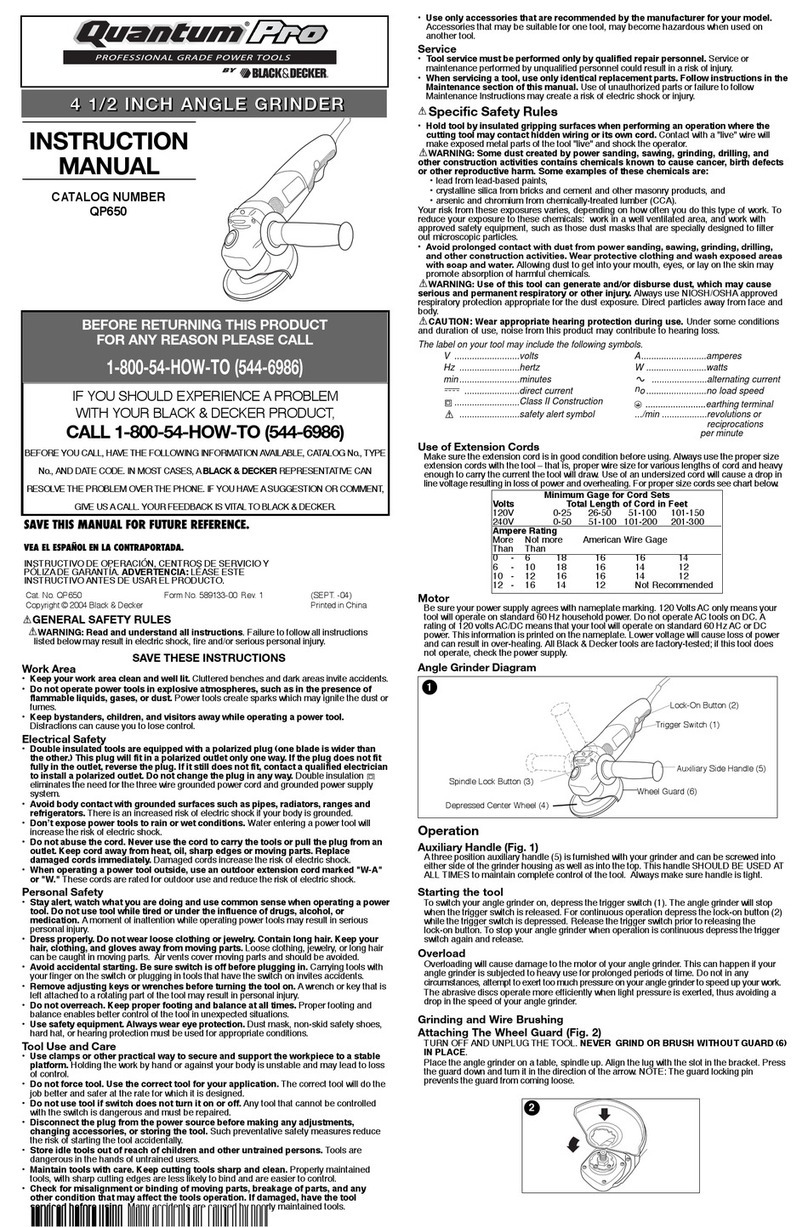
Quantum Pro
Quantum Pro QP650 instruction manual
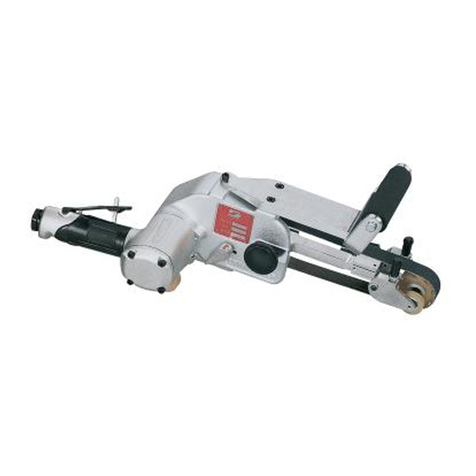
Dynabrade
Dynabrade Dynabelter 11486 Operating, maintenance and safety instructions

Beta
Beta 019330005 Operation manual and instructions
